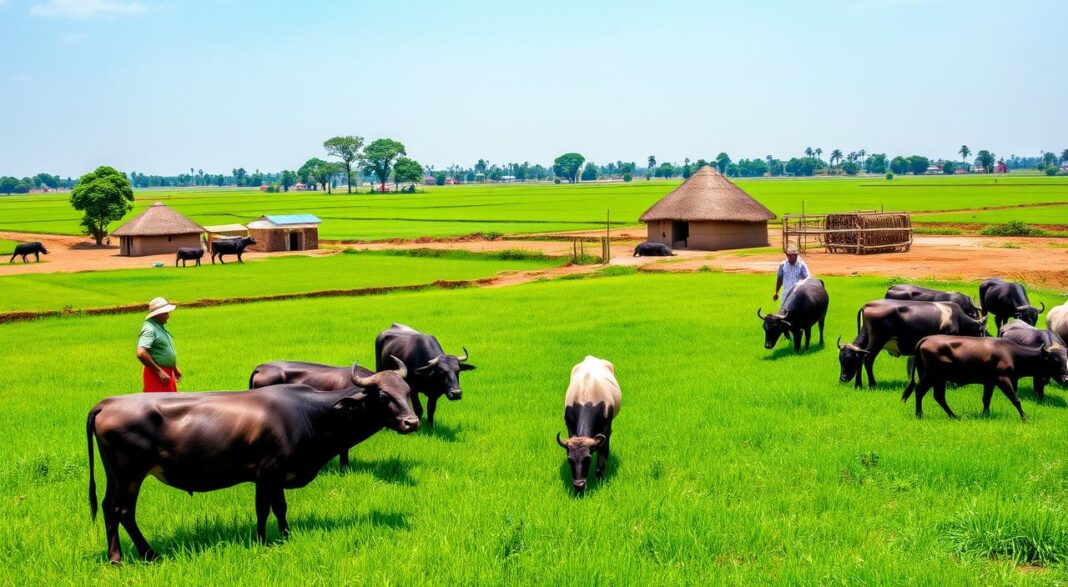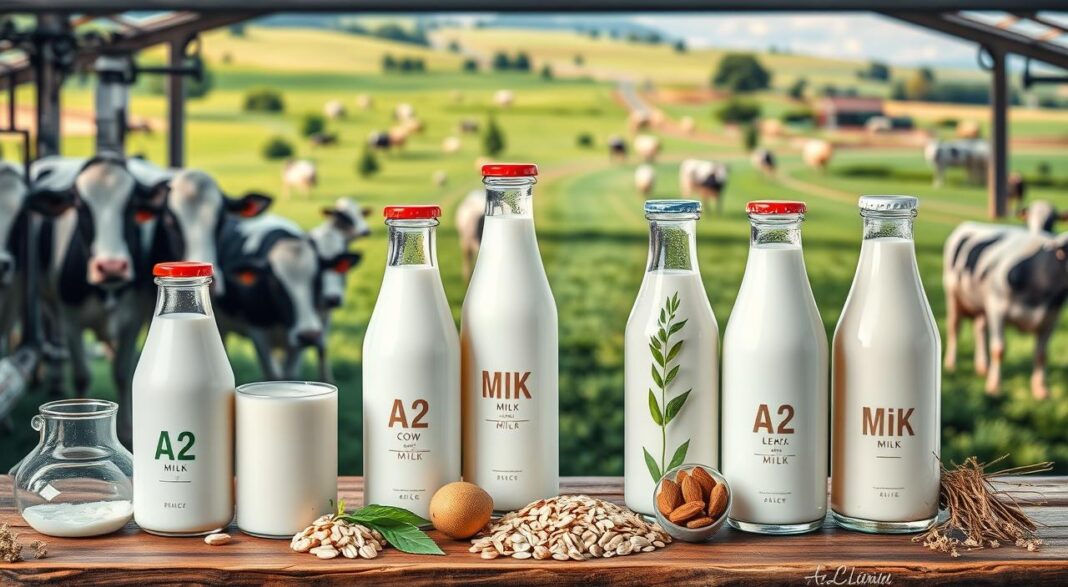Buffalo Longevity in India
Buffalo farming is crucial for India’s agricultural sector, especially in dairy production. Buffaloes are renowned for their high milk yield compared to other bovines. They’re also used for draught power, meat, and leather.
Buffalo health directly impacts farmers’ livelihoods in India. Foot and Mouth Disease (FMD), Brucellosis, and Tuberculosis can rapidly spread among buffalo herds. These diseases decrease milk production and can cause mortality.
Vets recommend vaccines for FMD, Hemorrhagic Septicemia, Blackleg, and Bovine Tuberculosis. Biosecurity measures on farms are crucial. These include quarantine for new animals and restricting visitors.
Regular health check-ups and tests are vital for buffalo health. Keeping detailed health records helps track their well-being. This data includes weight, body condition, vaccinations, and disease history.
Key Points
- Buffaloes are a crucial component of India’s dairy industry, known for their high milk yield.
- Diseases like FMD, Brucellosis, and Tuberculosis can significantly impact buffalo health and productivity.
- Vaccinations and biosecurity measures are essential for protecting Indian buffaloes from diseases.
- Regular health check-ups and record-keeping are vital for monitoring buffalo health and well-being.
- Proper nutrition, including quality fodder, balanced macronutrients, and micronutrients, is necessary for optimal buffalo health and longevity.
Importance of Buffalo Farming in India
Buffalo farming is important to India’s livestock industry and agricultural economy. India has 56% of the world’s buffalo population, totaling 109 million animals. The buffalo farming significance provides a livelihood for millions of smallholder and landless farmers.

Economic Significance of Buffalo in India
Buffaloes are the main source of milk in India, producing over 50% of the total. India leads the world in milk production with over 140 million tonnes annually. Buffalo milk has higher fat content and fetches a better price than cow milk.
In 2015-16, India’s buffalo meat exports were worth Rs 26,685.44 crore. This shows the buffalo economy’s major contribution to India’s foreign exchange earnings. Buffaloes also provide meat, hides, bones, and draft power for farming.
Role of Buffaloes in Indian Agriculture
Buffaloes thrive on low-quality feeds and coarse fodder. This makes them ideal for smallholder farmers with limited resources. They provide draft power for plowing, irrigation, and transportation.
Buffalo manure is a valuable organic fertilizer. It enhances soil fertility and crop productivity. Integrating buffaloes into farming systems boosts the sustainability of Indian agriculture.
| Breed | Average Lactation Yield (kg) | Milk Fat Content (%) |
|---|---|---|
| Murrah | 1752 | 7 |
| Surti | – | 8-12 |
| Jaffarabadi | 2239 | – |
| Mehsana | 1988 | 6.83 |
India has a rich variety of high-producing buffalo breeds. These include Murrah, Nili-Ravi, Jaffarabadi, Surti, Mehsana, and Bhadawari. Their average lactation yields range from 1294 kg to 2239 kg.
The National Academy of Agricultural Sciences conducted a Brainstorming Session on 'Breeding Policy for Cattle and Buffalo in India' in July 2014, involving experts in animal breeding, reproduction, production, health, and the dairy industry. The session aimed to enhance the production and productivity of major livestock species in India, focusing on balanced nutrition, health protection, bio-security, and efficient management.
Buffalo farming is vital to Indian agriculture. It contributes to food security, rural livelihoods, and economic growth. India has the world’s largest buffalo population and diverse high-yielding breeds.
This gives India huge potential to grow its buffalo industry. It can maintain its position as a global leader in buffalo milk production.
Indian Buffalo Breeds and Their Characteristics
India boasts a variety of native buffalo breeds. Each has unique traits suited to its local environment. These breeds are vital to India’s farming and dairy sectors.
They’ve supported farmers’ livelihoods and the economy for centuries. Let’s explore some key Indian buffalo breeds and their special features.
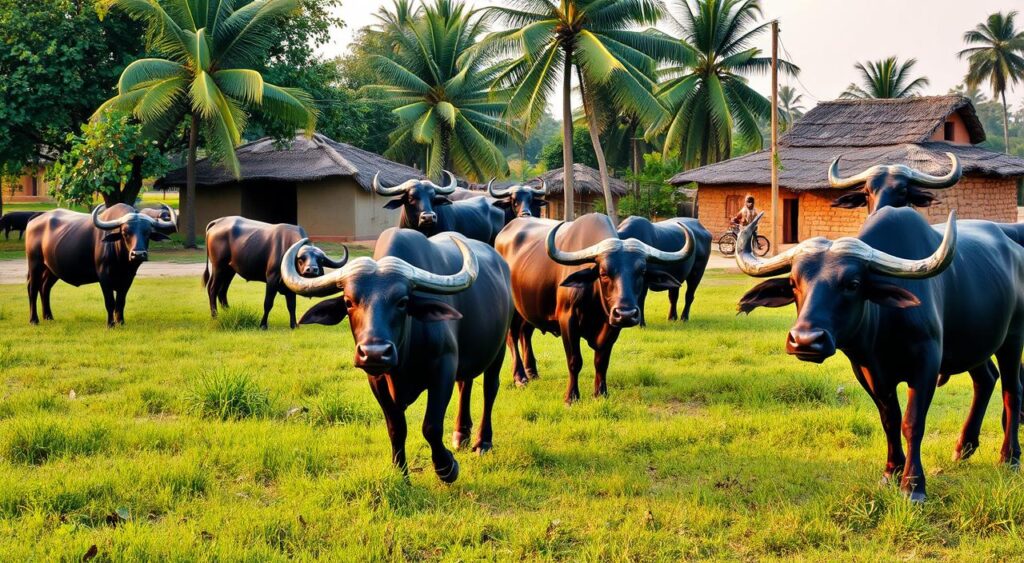
Murrah Buffalo
Murrah buffaloes come from Haryana state. They’re known for jet-black skin and curved horns. These buffaloes are top milk producers.
They yield 1500 to 2000 kg of milk per lactation. Dairy farmers prize them for their high productivity.
Surti Buffalo
Surti buffaloes are native to Gujarat. Their coat color ranges from rusty brown to silver-grey. Their milk has high fat content, between 8-12%.
This makes it ideal for ghee and dairy products. Surti buffaloes produce 900 to 1300 kg of milk per lactation.
Jaffarabadi Buffalo
Jaffarabadi buffaloes are found in Gujarat’s Gir forests. They’re known for their massive size and heavy, drooping horns. These buffaloes thrive in hot, humid conditions.
They produce about 1100 kg of milk per lactation. Their adaptability makes them valuable in certain regions.
Mehsana Buffalo
Mehsana buffaloes are mostly found in Gujarat. They’re typically black with a wide, slightly depressed forehead. This breed results from crossing Surti and Murrah buffaloes.
Mehsana buffaloes combine the best traits of both parent breeds. They yield 1200 to 1500 kg of milk per lactation.
| Buffalo Breed | Average Milk Yield (kg/lactation) | Key Characteristics |
|---|---|---|
| Murrah | 1500 – 2000 | Jet black skin, tightly curved horns |
| Surti | 900 – 1300 | Rusty brown to silver-grey coat, high milk fat content (8-12%) |
| Jaffarabadi | 1100 | Massive size, heavy horns that incline and droop |
| Mehsana | 1200 – 1500 | Mostly black, wide forehead with slight depression |
Indian buffalo breeds are crucial to the country’s dairy industry. They produce over 55% of India’s total milk output. Preserving these breeds is vital for sustainable farming.
As dairy demand grows, these buffaloes become more important. They ensure a bright future for both animals and the communities relying on them.
Factors Affecting Buffalo Longevity in India
Farmers and livestock owners must understand key factors influencing buffalo lifespan in India. These buffalo longevity determinants are crucial for improving animal well-being and productivity. Focusing on these factors can enhance the health of these valuable animals.
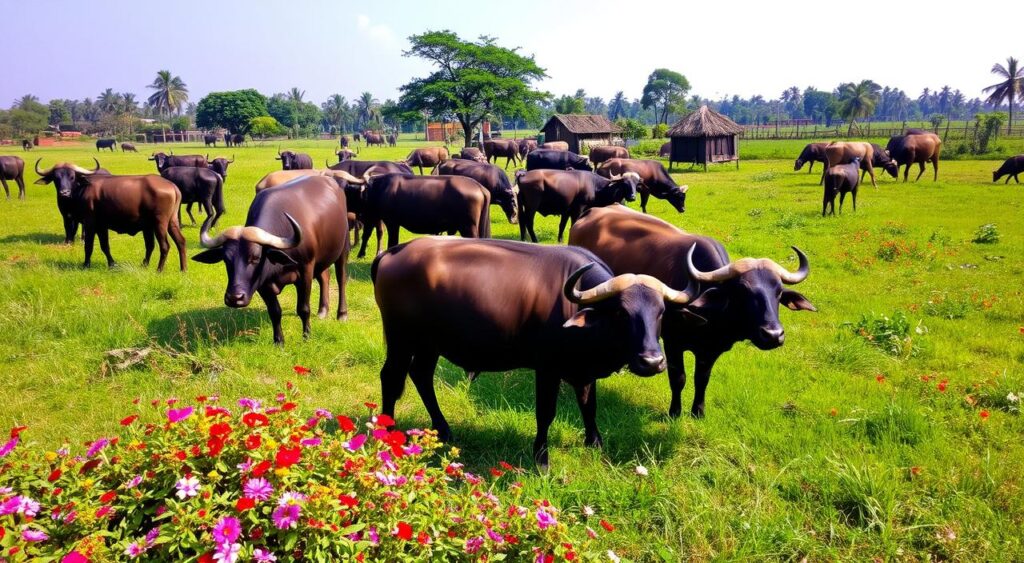
Proper nutrition is a vital buffalo health factor. High-quality fodder and a balanced diet are essential for maintaining buffalo health and immunity. A study on Murrah buffaloes revealed interesting findings about their lifespan and milk production.
The study showed an average productive life of 1275.24±31.82 days. Lifetime milk production was 5586.42±17.96. Calving period significantly affected both measures, with a decreasing trend over time. For more information, visit India Veterinary Community.
Regular vaccinations and deworming protect buffaloes from diseases and parasitic infections. Clean living spaces and proper grooming prevent infections and promote overall well-being. These measures significantly impact buffalo lifespan.
"Environmental factors have a greater impact on buffalo productivity than genetic factors, emphasizing the importance of proper management practices in ensuring buffalo longevity and health." - Researchers from the National Dairy Research Institute, India
Genetic factors and selective breeding also contribute to improved buffalo lifespan. A study on Nili-Ravi buffaloes found that age at first calving affects herd life. Buffaloes calving earlier tend to have a longer productive life.
The study classified age at first calving into six categories:
- ≤ 36 months
- > 36–42 months
- > 42–48 months
- > 48–54 months
- > 54–60 months
- > 60 months
Effective herd health management and regular vet check-ups are vital. They help detect and treat health issues early. Monitoring key buffalo health factors ensures the long-term well-being of herds.
| Breed | Lifetime Milk Yield (kg) | Productive Life (days) |
|---|---|---|
| Nili-Ravi | 7,723 | 3,990 |
| Murrah | 5,586 | 1,275 |
Understanding buffalo lifespan factors is crucial for promoting animal health in India. Best practices in nutrition, healthcare, and management ensure long-term productivity. These steps help maintain the well-being of buffalo herds.
Nutrition and Diet for Healthy Buffaloes
Good nutrition is key for healthy, long-lived, and productive buffaloes in India. A balanced diet helps buffaloes grow, reproduce, and stay well. It also boosts their resistance to diseases and stress.
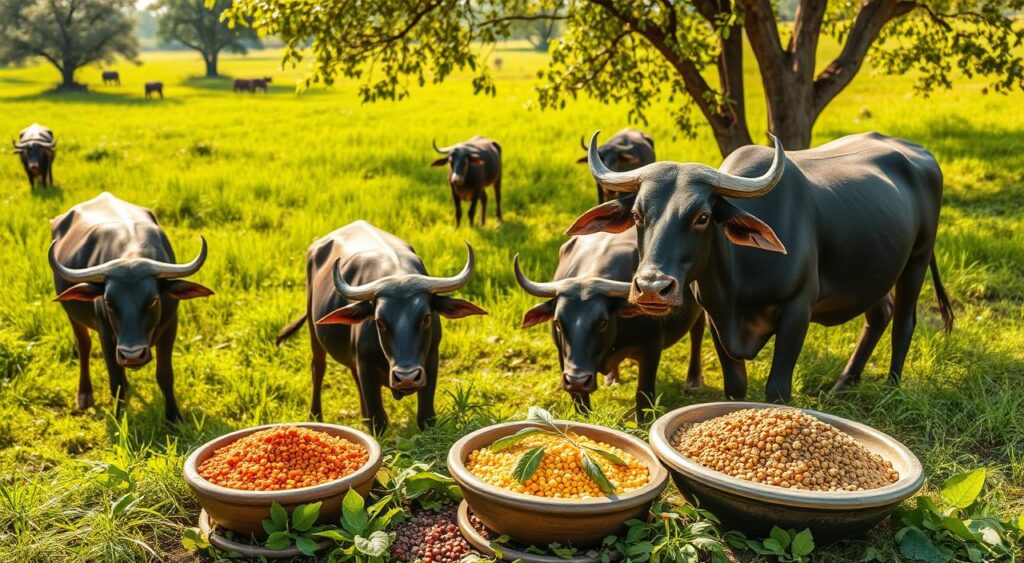
Importance of Quality Fodder and Water
High-quality fodder and clean water are essential for buffalo health. Fresh, nutrient-rich fodder should be free from mold and toxins. CO3, CO4, Bermuda grass, and lucerne provide vital carbs and fiber.
Buffaloes need two-thirds dry fodder and one-third green fodder. Clean water is crucial too. Buffaloes may travel 3 km for fresh grazing, so easy water access is important.
Balancing Macronutrients and Micronutrients
Buffaloes need the right mix of carbs, proteins, fats, vitamins, and minerals. They require 2.5 to 3 kg dry matter per 100 kg body weight daily. Concentrates vary based on needs.
For lactating buffaloes, a Ca:P ratio of 1.5:1 to 2.5:1 is vital. Too much protein can harm fertility. Lack of minerals like Mn and Cu can cause health issues.
Supplements for Optimal Buffalo Health
Supplements can help in certain cases. Bypass fat can improve milk production and reduce calving intervals. Vitamins, minerals, and probiotics support overall health.
Consult a vet or nutritionist for a custom supplement plan. Consider age, sex, production stage, and environment when creating a plan.
| Nutrient | Importance | Sources |
|---|---|---|
| Energy | Maintenance, growth, and production | Carbohydrates and fats from fodder and concentrates |
| Protein | Muscle development, milk production, and reproduction | Legumes, oilseed cakes, and protein supplements |
| Calcium and Phosphorus | Bone health, milk production, and reproductive efficiency | Forages, mineral supplements, and bone meal |
| Vitamins (A, D, E) | Immune function, reproduction, and overall health | Green fodder, sun-cured hay, and vitamin supplements |
A balanced diet rich in essential nutrients promotes buffalo health and productivity. Quality fodder, clean water, and proper supplements contribute to successful buffalo farming in India.
Housing Management for Buffalo Longevity
Buffalo housing management is vital for their longevity and well-being in India. A good shelter offers comfort and hygiene, meeting the animals’ needs. It should be spacious, well-ventilated, and have clean bedding.
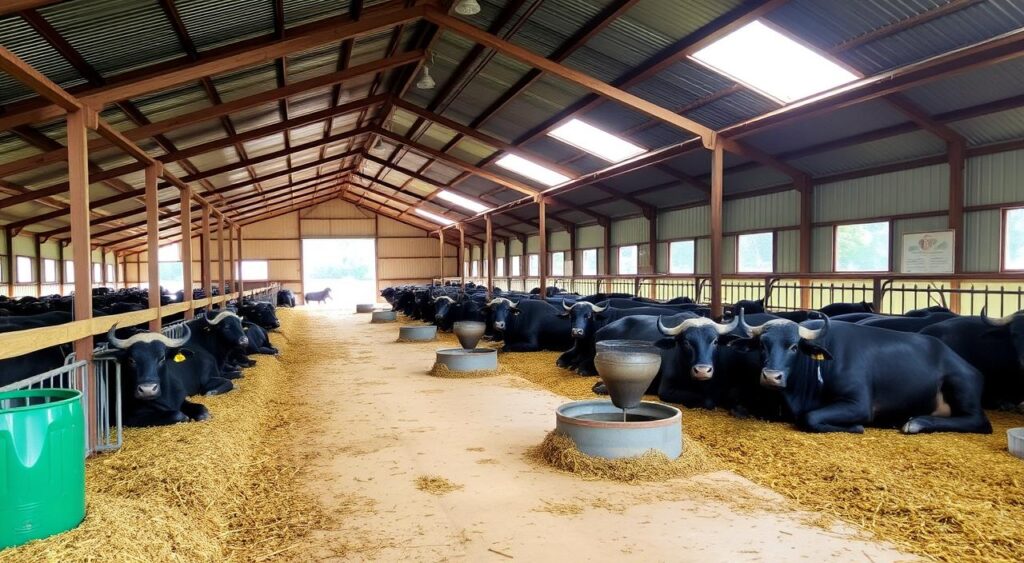
Space allowance is crucial for buffalo welfare, behavior, and health. Studies show that optimal floor space improves social indices and reduces stress. Limited space can lead to higher stress levels in buffalo calves.
Loose housing systems are ideal for buffalo longevity. They allow free movement except during milking and treatment. This system is economical and helps detect animals in heat easily.
The space allowance for animals is crucial for their welfare and health, impacting their behavior and productivity. Optimal floor space for buffalo can improve their welfare and social indices.
Good housing management includes proper ventilation and clean bedding. Regular cleaning prevents respiratory issues and promotes overall health. These practices are key to buffalo longevity.
Investing in suitable shelters and effective management strategies benefits buffalo herds. It enhances their well-being and increases farm productivity.
| Buffalo Housing Type | Advantages |
|---|---|
| Loose Housing |
|
| Conventional Sheds |
|
Prioritizing housing management improves buffalo longevity and productivity in India. Good shelter, ventilation, and hygiene boost animal health. This approach enhances the sustainability and profitability of buffalo farming.
Preventive Healthcare Practices for Buffaloes
A comprehensive buffalo healthcare plan is vital for healthy, productive herds in India. Regular vaccinations, deworming, and hoof care are key to effective buffalo health management.
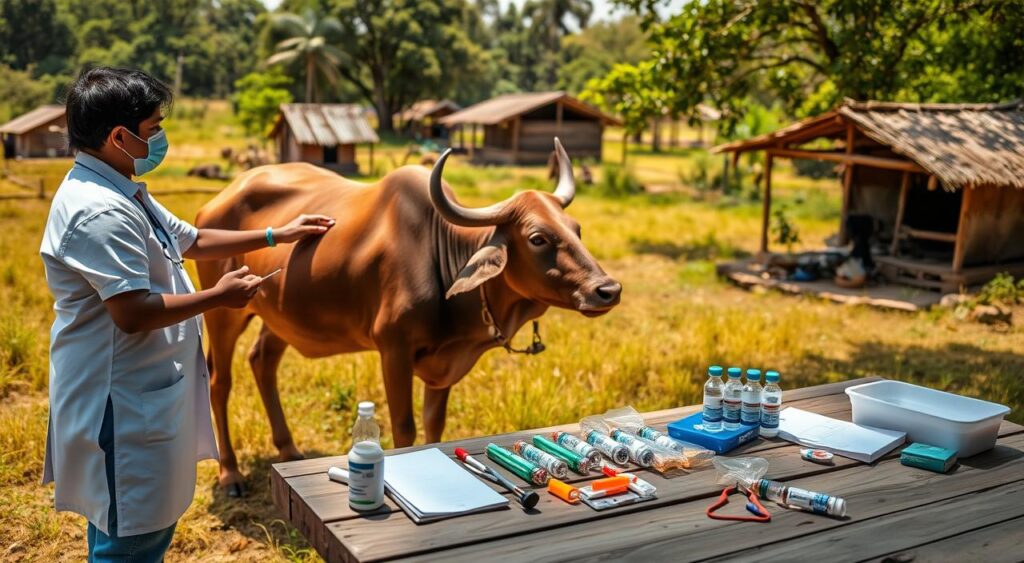
Regular Vaccinations and Deworming
Vaccinating buffaloes prevents disease outbreaks and ensures herd health. Key vaccines include FMD, HS, BQ, and rabies.
Vaccination schedules vary by disease and buffalo age. Consult a vet for the best vaccination plan for your herd.
- FMD (Foot and Mouth Disease) vaccines like Bovilis®Clovax and Raksha, with primary vaccination starting at 3 months of age
- Raksha HS (Haemorrhagic Septicemia) vaccine for buffaloes 6 months and above, with annual revaccination
- Compound vaccines for FMD, HS, and BQ (Brucellosis) administered at 4-month intervals
- Bruvax, a Brucellosis vaccine for 4-8 months old serologically negative female calves
- Raksha-Anthrax vaccination one month before the grazing season or disease occurrence
- Raksharab rabies vaccine for buffaloes 3 months and above, with boosters and annual vaccination in endemic areas
Studies show high disease prevalence in livestock. FMD affects 57% of Orissa goats. Black quarter disease causes economic losses in cattle and buffaloes.
Regular deworming controls parasitic infections in buffaloes. Consult a vet to create a deworming schedule based on local parasite prevalence.
Hoof Care and Grooming
Proper hoof care prevents lameness in buffaloes. Trim and clean hooves regularly to avoid overgrowth and infections.
Keep housing clean and dry to reduce hoof problems. Groom buffaloes often to maintain skin and coat health.
Mondal and Yamage (2014) conducted a retrospective epidemiological study on haemorrhagic septicaemia and anthrax in India, highlighting the ongoing concerns posed by these diseases in the country's livestock population.
Implementing preventive care can be challenging. Studies show mixed adoption rates of livestock vaccination in India.
Education initiatives have improved awareness about vaccinations. This has led to increased immunization uptake among farmers.
Prioritizing preventive care improves buffalo health and productivity. This contributes to sustainable and profitable farming operations in India.
Common Health Issues Affecting Buffalo Lifespan
Buffaloes face various health issues that can impact their lifespan and productivity. They’re more resilient to diseases than cattle but still vulnerable to several problems. Quick identification and treatment are crucial for maintaining healthy buffalo herds in India.

Parasitic Infections in Buffaloes
Parasitic infections are a major threat to buffalo health. River buffaloes are more prone to these infections due to their wallowing behavior. Both internal and external parasites can cause problems.
Symptoms include weight loss, poor coat condition, and diarrhea. Regular deworming and good hygiene are essential to prevent infections. Farmers should work with vets to create effective parasite control programs.
Reproductive Disorders and Their Management
Reproductive disorders can hurt buffalo fertility and efficiency. This affects their lifespan and productivity. Common issues include anestrus, repeat breeding, and uterine infections.
- Anestrus: A condition where buffaloes fail to exhibit regular estrous cycles.
- Repeat breeding: When buffaloes fail to conceive after multiple inseminations.
- Uterine infections: Infections of the uterus that can lead to infertility and other complications.
Good nutrition is key for reproductive health in buffaloes. Timely breeding based on accurate estrus detection can improve conception rates. Regular check-ups help identify and address issues early.
Vets may use ultrasound and other tools for diagnosis. Treatment can include hormonal therapy or antibiotics, depending on the problem.
According to a study, the age at first calving for river buffaloes ranges from 36 to 56 months, with a calving interval of 15–21 months. Proper management of reproductive health can help optimize these parameters and improve overall herd productivity.
| Reproductive Parameter | Value |
|---|---|
| Age at puberty | 15–36 months |
| Oestrus cycle length | 21 days |
| Oestrus duration | 12–30 hours |
| Gestation period | 305–320 days |
| First service conception rate (frozen semen) | 10–50% |
| Pregnancy rates with frozen semen (India and Pakistan) | 25–45% |
Other health issues affecting buffalo lifespan include mastitis, lameness, and metabolic disorders. Regular monitoring and vet care are essential. Early detection and proper treatment help maintain buffalo health and longevity in India.
Buffalo Longevity in India: Current Status and Trends
India leads the world in buffalo milk and meat production. The country houses over 113 million buffaloes, more than half the global population. Indian buffaloes typically live 18 to 25 years, with some reaching 30.
Recent studies highlight factors affecting buffalo longevity in India. Genetic traits play a key role, with breeds like Murrah and Jaffarabadi living longer. Environmental factors such as nutrition and healthcare also impact lifespan trends.
India’s buffalo industry now focuses on improving animal welfare and extending productive life. Farmers and researchers are working to enhance buffalo longevity. They’re optimizing nutrition, improving healthcare, and using scientific breeding practices.
"Buffalo longevity is not just about extending their lifespan, but also about ensuring their health and productivity throughout their lives. By investing in research and implementing best practices, we can significantly improve the welfare of these animals and support the livelihoods of millions of farmers in India."
- Dr. Rajesh Sharma, Senior Scientist, National Dairy Research Institute
The following table highlights some key statistics related to buffalo longevity in India:
| Parameter | Value |
|---|---|
| Average Lifespan | 18-25 years |
| Maximum Recorded Lifespan | 30+ years |
| Productive Life (Lactation) | 10-15 years |
| Age at First Calving | 3-4 years |
| Calving Interval | 14-16 months |
Buffalo aging research is progressing, bringing hope for improved longevity and health. Targeted interventions and evidence-based practices can ensure a bright future for India’s buffalo industry. These efforts will support the sustainability of these remarkable animals.
Strategies for Improving Buffalo Lifespan and Health
Buffalo farming in India relies on enhancing longevity and health. With 200 million buffaloes globally, India houses a significant portion. Farmers must focus on key areas to ensure herd well-being and productivity.
These areas include genetic selection, nutrition, healthcare, and herd management. By addressing these aspects, farmers can boost their buffalo herds’ success.
Genetic Selection for Longevity Traits
Genetic selection is vital for improving buffalo lifespan and health. Breeding buffaloes with desirable traits can develop resilient, long-lived herds. The Murrah buffalo, popular in India, yields 1,181-1,934 kg milk per lactation.
Genomic tools help identify genes linked to buffalo longevity and health. Breeders can make informed decisions when selecting stock. This leads to more robust buffalo populations.
Implementing Effective Herd Health Management Programs
Effective herd health management is crucial for buffalo longevity. Regular check-ups, health monitoring, and prompt treatment are key. Preventive measures like vaccinations and deworming protect against diseases and parasites.
Proper nutrition is critical for buffalo herd management. High-quality fodder and balanced diets provide essential nutrients. In India, buffaloes supply 59.3% of total milk produced.
| Strategy | Benefits |
|---|---|
| Genetic Selection for Longevity Traits | Develops more resilient and long-lived herds, enhances productivity over an extended period |
| Effective Herd Health Management | Maintains overall health, reduces mortality rates, extends lifespan |
| Proper Nutrition | Ensures optimal health, maintains high milk yields, extends productive life |
Combining herd health management with genetic selection improves buffalo lifespan and health. These strategies optimize productivity and profitability. They also ensure the well-being of buffalo farming operations.
Future Prospects and Research on Buffalo Longevity
Buffalo longevity research in India shows great promise. Scientists are working to identify factors that affect buffalo lifespan. Their goal is to develop ways to promote healthy aging in these animals.
Studies are exploring the link between longevity and milk production. This research aims to optimize breeding strategies. The focus is on creating long-lived, high-yielding animals.
Veterinary researchers are teaming up with aging biology experts. They’re developing new buffalo health innovations. Their work applies insights from lab studies to buffalo populations.
Scientists hope to create new therapies and management practices. These could extend the productive lifespan of buffaloes. Some promising research areas include:
- Identification of biomarkers of aging in buffaloes
- Development of nutritional interventions to support healthy aging
- Exploration of genetic and epigenetic factors influencing buffalo longevity
- Design of targeted healthcare strategies to prevent age-related diseases
"The future of buffalo longevity research lies in the integration of cutting-edge scientific techniques with traditional knowledge of animal husbandry. By working together, researchers and farmers can unlock the secrets of buffalo aging and ensure the long-term health and productivity of these vital animals." - Dr. Rajesh Sharma, Senior Scientist at the National Dairy Research Institute
Buffalo longevity research could transform the dairy industry. Breeding longer-lived, healthier buffaloes can increase farm efficiency. It can also improve animal welfare and sustainability.
Ongoing investment in buffalo aging studies is crucial. It supports the development of innovative health interventions. This research benefits both buffaloes and the communities that rely on them.
| Research Area | Potential Impact |
|---|---|
| Genetic markers of longevity | Improved breeding strategies for long-lived buffaloes |
| Nutritional interventions | Enhanced health and longevity through targeted dietary supplementation |
| Biomarkers of aging | Early detection and prevention of age-related health issues |
| Healthcare innovations | Development of targeted therapies to promote healthy aging in buffaloes |
Conclusion
Buffalo longevity is crucial in India’s agricultural landscape. These resilient animals live about 20 years with a productive herd life of 1520.7 ± 46.2 days. Buffaloes significantly contribute to farmers’ livelihoods and the overall economy.
The Murrah breed produces an impressive 5441.6 ± 206.0 kg of milk in its lifetime. This highlights the importance of buffalo health in maintaining a sustainable milk supply.
Genetic studies show promising ways to boost buffalo longevity. Heritability estimates are 0.13 for longevity and 0.25 for 305-day milk yield. A strong genetic correlation of 0.77 between these traits exists.
Selecting for higher milk yield can indirectly improve longevity. Advanced genomic evaluation techniques like ssGBLUP help breeders make informed decisions for long-term herd improvement.
Prioritizing buffalo health and longevity is key for sustainable livestock development. Implementing scientific management practices can unlock these animals’ full potential. These include optimal nutrition, healthcare, and breeding strategies.
Research collaborations between veterinary scientists and aging biology experts are vital. They can uncover buffalo longevity secrets and create targeted interventions. Education, extension services, and applying scientific findings are crucial.
These efforts can secure a thriving buffalo farming industry. It will benefit both the animals and India’s farming community.

